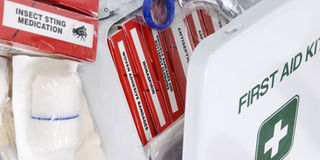Why basic first aid knowledge should be compulsory

Carrying a first aid kit in your car is a jolly good idea. But making it legally compulsory would be daft. Especially if the law didn’t specify what had to be in it. PHOTO | FILE
What you need to know:
- Where first aid could and should have legal status is when dealing with life-threatening injuries from an accident. And when that happens, the only kit you might need is rubber gloves.
- Beyond that, anyone who knows what s/he is doing won’t need a first aid kit, and anyone who doesn’t know what s/he is doing shouldn’t try to use one.
Carrying a first aid kit in your car is a jolly good idea. But making it legally compulsory would be daft. Especially if the law didn’t specify what had to be in it.
An aspirin? A sticking plaster? Some antiseptic cream perhaps, and pills in case someone in the vehicle gets the runs? A safety pin, a needle, some cotton thread, a pair of scissors, and a bandage? Some eyewash and antihistamine? By all means pack all of that, and more, to help deal with all the little troubles that can arise on a safari.
But that’s your choice. Not a legal issue. No one is going to die if you don’t carry these remedies (and anyone with severe toothache might rather be dead anyway).
Where first aid could and should have legal status is when dealing with life-threatening injuries from an accident. And when that happens, the only kit you might need is rubber gloves. Beyond that, anyone who knows what s/he is doing won’t need a first aid kit, and anyone who doesn’t know what s/he is doing shouldn’t try to use one.
AVOIDABLE DEATHS
Basic first aid “knowledge” is the essential and arguably only thing that might help keep someone alive until an ambulance and paramedics (second aid) or a fully equipped operating theatre (third aid) arrive … with oxygen, defibrillators, blood transfusions, adrenalin …
Emergency first aid is what you can do before that to prevent an avoidable death. For the full details, talk to an expert. But for the cardinal principles, it is axiomatic that to avoid death you need to sustain the essentials of life. The essentials are breathing, adequate blood supply, and a pulse to pump it. If breathing is not happening you need to get it started or substituted with all possible haste, and to do that you need to know how to position the patient, how to prevent choking, and preferably how to administer artificial respiration and/or cardiopulmonary resuscitation (CPR). The value of a first aid kit in those respects is zero.
If there is major blood loss you need to stop it immediately by applying pressure to the wound. If there’s no pulse, CPR is urgent. Again, the absolute need for a first aid kit is nil.
Though some sterile pads and a bandage to hold them can be helpful, their job can be done with all sorts of other materials that will be at hand. Start with your shirt.
Consciousness is a good sign, and can be helpful to managing the patient, but it is not essential and, again, you will not find it in a first aid kit. Beyond those most basic things, it is more important to know what you should not (repeat not) do, than to know what you might try to do (usually the less the better).
When breathing, bleeding, pulse and consciousness have been attended to, priority attention should be given to managing the scene – getting someone to call for expert help, others to warn on-coming motorists, etc – and keeping the injured person warm, calm and reassured.
What the law could consider is to insist these principles are taught and tested. Knowledge of them should definitely be carried in every vehicle. They are immeasurably more important, and more likely to save a life, than any first aid kit.





